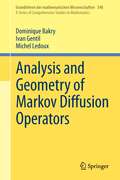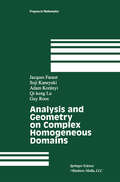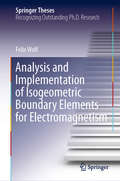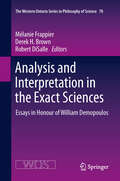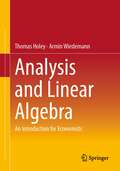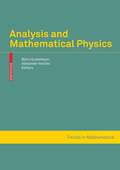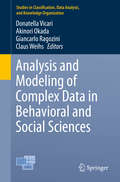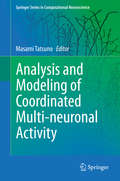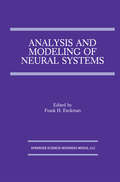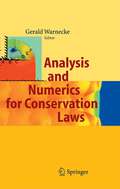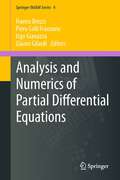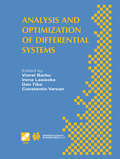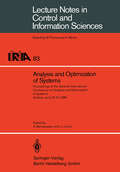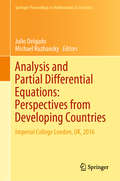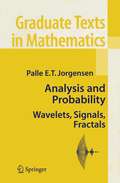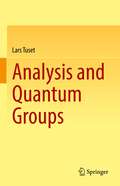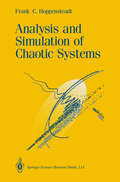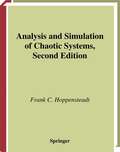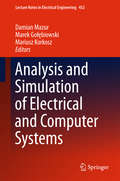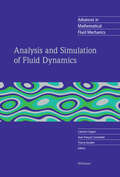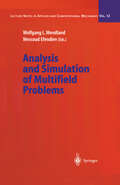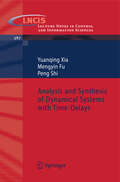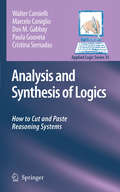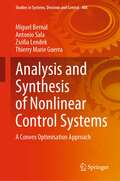- Table View
- List View
Analysis and Geometry of Markov Diffusion Operators (Grundlehren der mathematischen Wissenschaften #348)
by Dominique Bakry Ivan Gentil Michel LedouxThe present volume is an extensive monograph on the analytic and geometric aspects of Markov diffusion operators. It focuses on the geometric curvature properties of the underlying structure in order to study convergence to equilibrium, spectral bounds, functional inequalities such as Poincaré, Sobolev or logarithmic Sobolev inequalities, and various bounds on solutions of evolution equations. At the same time, it covers a large class of evolution and partial differential equations. The book is intended to serve as an introduction to the subject and to be accessible for beginning and advanced scientists and non-specialists. Simultaneously, it covers a wide range of results and techniques from the early developments in the mid-eighties to the latest achievements. As such, students and researchers interested in the modern aspects of Markov diffusion operators and semigroups and their connections to analytic functional inequalities, probabilistic convergence to equilibrium and geometric curvature will find it especially useful. Selected chapters can also be used for advanced courses on the topic.
Analysis and Geometry on Complex Homogeneous Domains (Progress in Mathematics #185)
by Jacques Faraut Soji Kaneyuki Adam Koranyi Qi-keng Lu Guy RoosA number of important topics in complex analysis and geometry are covered in this excellent introductory text. Written by experts in the subject, each chapter unfolds from the basics to the more complex. The exposition is rapid-paced and efficient, without compromising proofs and examples that enable the reader to grasp the essentials. The most basic type of domain examined is the bounded symmetric domain, originally described and classified by Cartan and Harish- Chandra. Two of the five parts of the text deal with these domains: one introduces the subject through the theory of semisimple Lie algebras (Koranyi), and the other through Jordan algebras and triple systems (Roos). Larger classes of domains and spaces are furnished by the pseudo-Hermitian symmetric spaces and related R-spaces. These classes are covered via a study of their geometry and a presentation and classification of their Lie algebraic theory (Kaneyuki). In the fourth part of the book, the heat kernels of the symmetric spaces belonging to the classical Lie groups are determined (Lu). Explicit computations are made for each case, giving precise results and complementing the more abstract and general methods presented. Also explored are recent developments in the field, in particular, the study of complex semigroups which generalize complex tube domains and function spaces on them (Faraut). This volume will be useful as a graduate text for students of Lie group theory with connections to complex analysis, or as a self-study resource for newcomers to the field. Readers will reach the frontiers of the subject in a considerably shorter time than with existing texts.
Analysis and Implementation of Isogeometric Boundary Elements for Electromagnetism (Springer Theses)
by Felix WolfThis book presents a comprehensive mathematical and computational approach for solving electromagnetic problems of practical relevance, such as electromagnetic scattering and the cavity problems. After an in-depth introduction to the mathematical foundations of isogeometric analysis, which discusses how to conduct higher-order simulations efficiently and without the introduction of geometrical errors, the book proves quasi-optimal approximation properties for all trace spaces of the de Rham sequence, and demonstrates inf-sup stability of the isogeometric discretisation of the electric field integral equation (EFIE). Theoretical properties and algorithms are described in detail. The algorithmic approach is, in turn, validated through a series of numerical experiments aimed at solving a set of electromagnetic scattering problems. In the last part of the book, the boundary element method is combined with a novel eigenvalue solver, a so-called contour integral method. An algorithm is presented, together with a set of successful numerical experiments, showing that the eigenvalue solver benefits from the high orders of convergence offered by the boundary element approach. Last, the resulting software, called BEMBEL (Boundary Element Method Based Engineering Library), is reviewed: the user interface is presented, while the underlying design considerations are explained in detail. Given its scope, this book bridges an important gap between numerical analysis and engineering design of electromagnetic devices.
Analysis and Interpretation in the Exact Sciences: Essays in Honour of William Demopoulos (The Western Ontario Series in Philosophy of Science #78)
by Melanie Frappier, Derek Brown and Robert DiSalleThe essays in this volume concern the points of intersection between analytic philosophy and the philosophy of the exact sciences. More precisely, it concern connections between knowledge in mathematics and the exact sciences, on the one hand, and the conceptual foundations of knowledge in general. Its guiding idea is that, in contemporary philosophy of science, there are profound problems of theoretical interpretation-- problems that transcend both the methodological concerns of general philosophy of science, and the technical concerns of philosophers of particular sciences. A fruitful approach to these problems combines the study of scientific detail with the kind of conceptual analysis that is characteristic of the modern analytic tradition. Such an approach is shared by these contributors: some primarily known as analytic philosophers, some as philosophers of science, but all deeply aware that the problems of analysis and interpretation link these fields together.
Analysis and Linear Algebra: An Introduction for Economists
by Thomas Holey Armin WiedemannThis elementary introduction was developed from lectures by the authors on business mathematics and the lecture "Analysis and Linear Algebra" for Bachelor's degree programmes
Analysis and Mathematical Physics (Trends in Mathematics)
by Bjö Gustafsson Alexander Vasil'EvOur knowledge of objects of complex and potential analysis has been enhanced recently by ideas and constructions of theoretical and mathematical physics, such as quantum field theory, nonlinear hydrodynamics, material science. These are some of the themes of this refereed collection of papers, which grew out of the first conference of the European Science Foundation Networking Programme 'Harmonic and Complex Analysis and Applications' held in Norway 2007.
Analysis and Modeling of Complex Data in Behavioral and Social Sciences (Studies in Classification, Data Analysis, and Knowledge Organization)
by Donatella Vicari Akinori Okada Giancarlo Ragozini Claus WeihsThis volume presents theoretical developments, applications and computational methods for the analysis and modeling in behavioral and social sciences where data are usually complex to explore and investigate. The challenging proposals provide a connection between statistical methodology and the social domain with particular attention to computational issues in order to effectively address complicated data analysis problems.The papers in this volume stem from contributions initially presented at the joint international meeting JCS-CLADAG held in Anacapri (Italy) where the Japanese Classification Society and the Classification and Data Analysis Group of the Italian Statistical Society had a stimulating scientific discussion and exchange.
Analysis and Modeling of Coordinated Multi-neuronal Activity (Springer Series in Computational Neuroscience #12)
by Masami TatsunoSince information in the brain is processed by the exchange of spikes among neurons, a study of such group dynamics is extremely important in understanding hippocampus dependent memory. These spike patterns and local field potentials (LFPs) have been analyzed by various statistical methods. These studies have led to important findings of memory information processing. For example, memory-trace replay, a reactivation of behaviorally induced neural patterns during subsequent sleep, has been suggested to play an important role in memory consolidation. It has also been suggested that a ripple/sharp wave event (one of the characteristics of LFPs in the hippocampus) and spiking activity in the cortex have a specific relationship that may facilitate the consolidation of hippocampal dependent memory from the hippocampus to the cortex. The book will provide a state-of-the-art finding of memory information processing through the analysis of multi-neuronal data. The first half of the book is devoted to this analysis aspect. Understanding memory information representation and its consolidation, however, cannot be achieved only by analyzing the data. It is extremely important to construct a computational model to seek an underlying mathematical principle. In other words, an entire picture of hippocampus dependent memory system would be elucidated through close collaboration among experiments, data analysis, and computational modeling. Not only does computational modeling benefit the data analysis of multi-electrode recordings, but it also provides useful insight for future experiments and analyses. The second half of the book will be devoted to the computational modeling of hippocampus-dependent memory.
Analysis and Numerics for Conservation Laws
by Gerald WarneckeWhatdoasupernovaexplosioninouterspace,?owaroundanairfoil and knocking in combustion engines have in common? The physical and chemical mechanisms as well as the sizes of these processes are quite di?erent. So are the motivations for studying them scienti?cally. The super- 8 nova is a thermo-nuclear explosion on a scale of 10 cm. Astrophysicists try to understand them in order to get insight into fundamental properties of the universe. In ?ows around airfoils of commercial airliners at the scale of 3 10 cm shock waves occur that in?uence the stability of the wings as well as fuel consumption in ?ight. This requires appropriate design of the shape and structure of airfoils by engineers. Knocking occurs in combustion, a chemical 1 process, and must be avoided since it damages motors. The scale is 10 cm and these processes must be optimized for e?ciency and environmental conside- tions. The common thread is that the underlying ?uid ?ows may at a certain scale of observation be described by basically the same type of hyperbolic s- tems of partial di?erential equations in divergence form, called conservation laws. Astrophysicists, engineers and mathematicians share a common interest in scienti?c progress on theory for these equations and the development of computational methods for solutions of the equations. Due to their wide applicability in modeling of continua, partial di?erential equationsareamajor?eldofresearchinmathematics. Asubstantialportionof mathematical research is related to the analysis and numerical approximation of solutions to such equations. Hyperbolic conservation laws in two or more spacedimensionsstillposeoneofthemainchallengestomodernmathematics.
Analysis and Numerics of Partial Differential Equations (Springer INdAM Series)
by Franco Brezzi, Piero Colli Franzone, Ugo Gianazza and Gianni GilardiThis volume is a selection of contributions offered by friends, collaborators, past students in memory of Enrico Magenes. The first part gives a wide historical perspective of Magenes' work in his 50-year mathematical career; the second part contains original research papers, and shows how ideas, methods, and techniques introduced by Magenes and his collaborators still have an impact on the current research in Mathematics.
Analysis and Optimization of Differential Systems: IFIP TC7 / WG7.2 International Working Conference on Analysis and Optimization of Differential Systems, September 10–14, 2002, Constanta, Romania (IFIP Advances in Information and Communication Technology #121)
by Viorel Barbu Irena Lasiecka Dan Tiba Constantin VarsanAnalysis and Optimization of Differential Systems focuses on the qualitative aspects of deterministic and stochastic differential equations. Areas covered include: Ordinary and partial differential systems; Optimal control of deterministic and stochastic evolution equations;Control theory of Partial Differential Equations (PDE's); Optimization methods in PDE's with numerous applications to mechanics and physics; Inverse problems; Stability theory; Abstract optimization problems; Calculus of variations; Numerical treatment of solutions to differential equations and related optimization problems. These research fields are under very active development and the present volume should be of interest to students and researchers working in applied mathematics or in system engineering. This volume contains selected contributions presented during the International Working Conference on Analysis and Optimization of Differential Systems, which was sponsored by the International Federation for Information Processing (IFIP) and held in Constanta, Romania in September 2002. Among the aims of this conference was the creation of new international contacts and collaborations, taking advantage of the new developments in Eastern Europe, particularly in Romania. The conference benefited from the support of the European Union via the EURROMMAT program.
Analysis and Optimization of Systems: Proceedings of the Seventh International Conference on Ana- lysis and Optimization of Systems. Antibes, June 25-27, 1986 (Lecture Notes in Control and Information Sciences #83)
by A. Bensoussan J. L. LionsINRIA, Institut National de Recherche en Informatique et en Automatique
Analysis and Partial Differential Equations: Imperial College London, UK, 2016 (Springer Proceedings in Mathematics & Statistics #275)
by Julio Delgado Michael RuzhanskyThis volume presents current trends in analysis and partial differential equations from researchers in developing countries. The fruit of the project 'Analysis in Developing Countries', whose aim was to bring together researchers from around the world, the volume also includes some contributions from researchers from developed countries.Focusing on topics in analysis related to partial differential equations, this volume contains selected contributions from the activities of the project at Imperial College London, namely the conference on Analysis and Partial Differential Equations held in September 2016 and the subsequent Official Development Assistance Week held in November 2016. Topics represented include Fourier analysis, pseudo-differential operators, integral equations, as well as related topics from numerical analysis and bifurcation theory, and the countries represented range from Burkina Faso and Ghana to Armenia, Kyrgyzstan and Tajikistan, including contributions from Brazil, Colombia and Cuba, as well as India and China.Suitable for postgraduate students and beyond, this volume offers the reader a broader, global perspective of contemporary research in analysis.
Analysis and Probability: Wavelets, Signals, Fractals (Graduate Texts in Mathematics #234)
by Palle E. JorgensenCombines analysis and tools from probability, harmonic analysis, operator theory, and engineering (signal/image processing) Interdisciplinary focus with hands-on approach, generous motivation and new pedagogical techniques Numerous exercises reinforce fundamental concepts and hone computational skills Separate sections explain engineering terms to mathematicians and operator theory to engineers Fills a gap in the literature
Analysis and Quantum Groups
by Lars TusetThis volume presents a completely self-contained introduction to the elaborate theory of locally compact quantum groups, bringing the reader to the frontiers of present-day research. The exposition includes a substantial amount of material on functional analysis and operator algebras, subjects which in themselves have become increasingly important with the advent of quantum information theory. In particular, the rather unfamiliar modular theory of weights plays a crucial role in the theory, due to the presence of ‘Haar integrals’ on locally compact quantum groups, and is thus treated quite extensively The topics covered are developed independently, and each can serve either as a separate course in its own right or as part of a broader course on locally compact quantum groups. The second part of the book covers crossed products of coactions, their relation to subfactors and other types of natural products such as cocycle bicrossed products, quantum doubles and doublecrossed products. Induced corepresentations, Galois objects and deformations of coactions by cocycles are also treated. Each section is followed by a generous supply of exercises. To complete the book, an appendix is provided on topology, measure theory and complex function theory.
Analysis and Simulation of Chaotic Systems (Applied Mathematical Sciences #94)
by Frank C. HoppensteadtAnalysis and Simulation of Chaotic Systems is a text designed to be used at the graduate level in applied mathematics for students from mathematics, engineering, physics, chemistry and biology. The book can be used as a stand-alone text for a full year course or it can be heavily supplemented with material of more mathematical, more engineering or more scientific nature. Computations and computer simulations are used throughout this text to illustrate phenomena discussed and to supply readers with probes to use on new problems.
Analysis and Simulation of Chaotic Systems (Applied Mathematical Sciences #94)
by Frank C. HoppensteadtBeginning with realistic mathematical or verbal models of physical or biological phenomena, the author derives tractable models for further mathematical analysis or computer simulations. For the most part, derivations are based on perturbation methods, and the majority of the text is devoted to careful derivations of implicit function theorems, the method of averaging, and quasi-static state approximation methods. The duality between stability and perturbation is developed and used, relying heavily on the concept of stability under persistent disturbances. Relevant topics about linear systems, nonlinear oscillations, and stability methods for difference, differential-delay, integro-differential and ordinary and partial differential equations are developed throughout the book. For the second edition, the author has restructured the chapters, placing special emphasis on introductory materials in Chapters 1 and 2 as distinct from presentation materials in Chapters 3 through 8. In addition, more material on bifurcations from the point of view of canonical models, sections on randomly perturbed systems, and several new computer simulations have been added.
Analysis and Simulation of Contact Problems (Lecture Notes in Applied and Computational Mechanics #27)
by Peter Wriggers Udo NackenhorstThis carefully edited book offers a state-of-the-art overview on formulation, mathematical analysis and numerical solution procedures of contact problems. The contributions collected in this volume summarize the lectures presented by leading scientists in the area of contact mechanics, during the 4th Contact Mechanics International Symposium (CMIS) held in Hannover, Germany, 2005.
Analysis and Simulation of Electrical and Computer Systems (Lecture Notes in Electrical Engineering #452)
by Damian Mazur Marek Gołębiowski Mariusz KorkoszThis book addresses selected topics in electrical engineering, electronics and mechatronics that have posed serious challenges for both the scientific and engineering communities in recent years. The topics covered range from mathematical models of electrical and electronic components and systems, to simulation tools implemented for their analysis and further developments; and from multidisciplinary optimization, signal processing methods and numerical results, to control and diagnostic techniques. By bridging theory and practice in the modeling, design and optimization of electrical, electromechanical and electronic systems, and by adopting a multidisciplinary perspective, the book provides researchers and practitioners with timely and extensive information on the state of the art in the field — and a source of new, exciting ideas for further developments and collaborations. The book presents selected results of the XIII Scientific Conference on Selected Issues of Electrical Engineering and Electronics (WZEE 2016), held on May 04–08, 2016, in Rzeszów, Poland. The Conference was organized by the Rzeszów Division of Polish Association of Theoretical and Applied Electrical Engineering (PTETiS) in cooperation with the Faculty of Electrical and Computer Engineering of the Rzeszów University of Technology.
Analysis and Simulation of Fluid Dynamics (Advances in Mathematical Fluid Mechanics)
by Caterina Calgaro Jean-François Coulombel Thierry GoudonThis volume collects the contributions of a Conference held in June 2005 at the laboratoire Paul Painleve (UMR CNRS 8524) in Lille, France. The meeting was intended to review hot topics and future trends in fluid dynamics, with the objective to foster exchanges of various viewpoints (e.g. theoretical, and numerical) on the addressed questions. It comprises a collection of research articles on recent advances in the analysis and simulation of fluid dynamics.
Analysis and Simulation of Multifield Problems (Lecture Notes in Applied and Computational Mechanics #12)
by Wolfgang L. Wendland Messoud EfendievThe analysis and simulation of multifield problems have recently become one of the most actual and vivid areas of research. Although the individual subproblems of complex technical and physical phenomena often are understood separately, their interaction and coupling create not only new difficulties but also a complete new level and quality of interacting coupled field problems. Presented by leading experts this book includes recent results in these fields from the International Conference on Multifield Problems, April 8-10, 2002 at the University of Stuttgart, Germany.
Analysis and Synthesis of Dynamical Systems with Time-Delays (Lecture Notes in Control and Information Sciences #387)
by Yuanqing Xia Mengyin Fu Peng ShiTime-delay occurs in many dynamical systems such as biological systems, chemical systems, metallurgical processing systems, nuclear reactor, long transmission lines in pneumatic, hydraulic systems and electrical networks. Especially, in recent years, time-delay which exists in networked control s- temshasbroughtmorecomplexproblemintoanewresearcharea.Frequently, itisasourceofthegenerationofoscillation,instabilityandpoorperformance. Considerable e?ort has been applied to di?erent aspects of linear time-delay systems during recent years. Because the introduction of the delay factor renders the system analysis more complicated, in addition to the di?culties caused by the perturbation or uncertainties, in the control of time-delay s- tems, the problems of robust stability and robust stabilization are of great importance. This book presents some basic theories of stability and stabilization of systems with time-delay, which are related to the main results in this book. More attention will be paid on synthesis of systems with time-delay. That is, sliding mode control of systems with time-delay; networked control systems with time-delay; networked data fusion with random delay.
Analysis and Synthesis of Logics: How to Cut and Paste Reasoning Systems (Applied Logic Series #35)
by Walter Carnielli Marcelo Coniglio Dov M. Gabbay Paula Gouveia Cristina SernadasStarting with simple examples showing the relevance of cutting and pasting logics, the monograph develops a mathematical theory of combining and decomposing logics, ranging from propositional and first-order based logics to higher-order based logics as well as to non-truth functional logics. The theory covers mechanisms for combining semantic structures and deductive systems either of the same or different nature. The issue of preservation of properties is addressed.
Analysis and Synthesis of Nonlinear Control Systems: A Convex Optimisation Approach (Studies in Systems, Decision and Control #408)
by Miguel Bernal Antonio Sala Zsófia Lendek Thierry Marie GuerraThis book presents a modern perspective on the modelling, analysis, and synthesis ideas behind convex-optimisation-based control of nonlinear systems: it embeds them in models with convex structures.Analysis and Synthesis of Nonlinear Control Systems begins with an introduction to the topic and a discussion of the problems to be solved. It then explores modelling via convex structures, including quasi-linear parameter-varying, Takagi–Sugeno models, and linear fractional transformation structures. The authors cover stability analysis, addressing Lyapunov functions and the stability of polynomial models, as well as the performance and robustness of the models. With detailed examples, simulations, and programming code, this book will be useful to instructors, researchers, and graduate students interested in nonlinear control systems.
